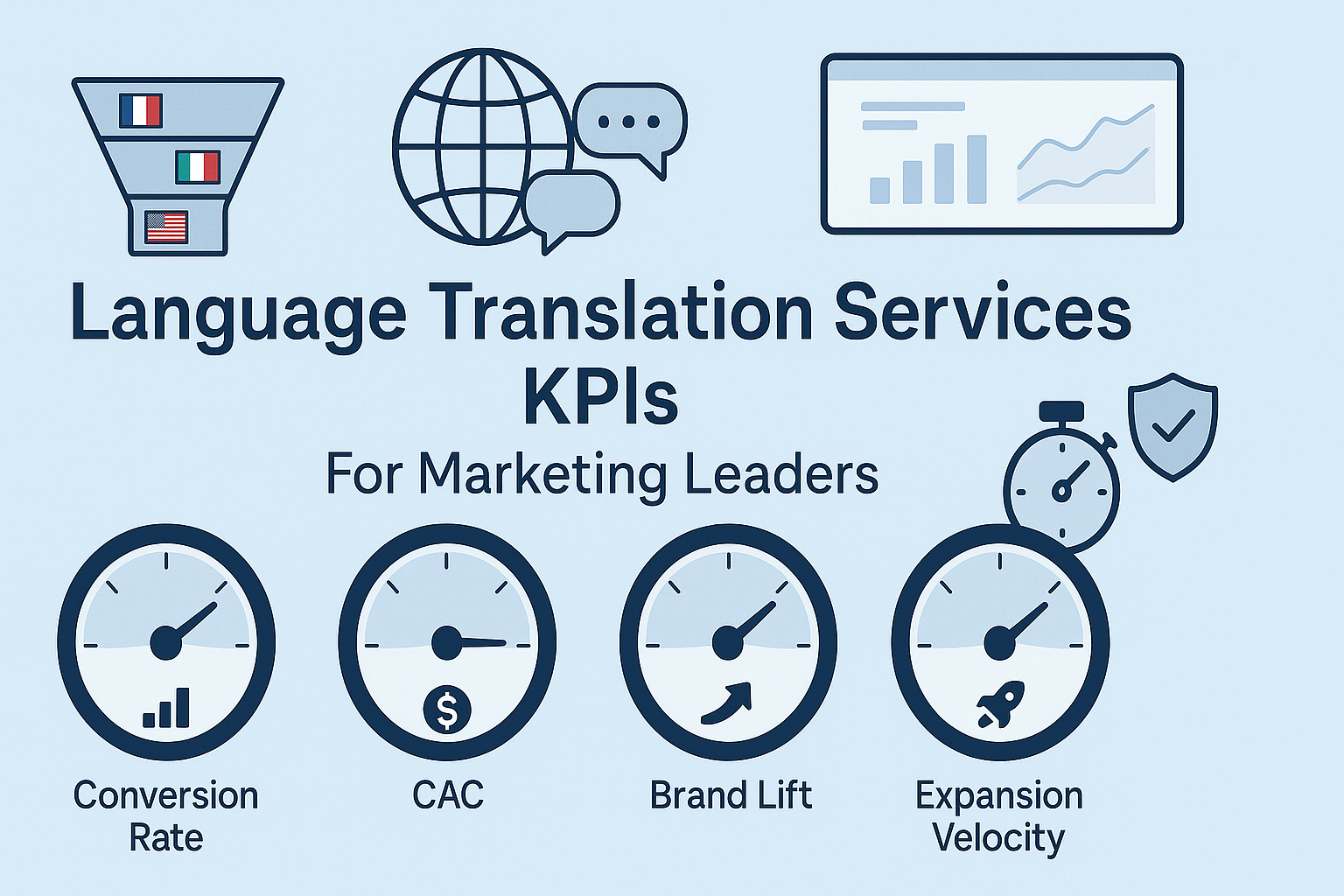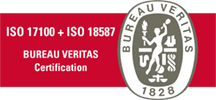Language translation services: KPIs every marketing leader should track
Marketing leaders use language translation services to remove friction, protect brand voice, and unlock growth. Here’s a practical KPI set that ties translation to revenue, efficiency, and risk.

Table of Contents
Why language translation services matter to Marketing KPIs
Marketing results depend on clarity and cultural fit. When messaging, legal notices, and UI text read as if written locally, you reduce drop-offs, rework, and complaints. The right partner aligns terminology, style, and review flow to your funnel goals. Start with a services hub like translation services and define which assets need specialist coverage—e.g., business translation for campaigns, legal translation for T&Cs, and technical translation for product sheets.
Authoritative guidance: W3C’s Internationalization Quick Tips and best practices explain how language, dates, and encoding impact UX and conversions (w3.org/International). For quality frameworks in our industry, see ISO 17100 for translation services requirements (iso.org).
Core KPI framework for CMOs
Organise KPIs into three families—Revenue, Efficiency, and Risk/Brand—so results map to your OKRs.
Revenue
- Localized Conversion Rate (LCR): per-locale CVR for key CTAs (demo, cart, signup). Track pre/post localisation deltas on pages translated via translation services.
- International Revenue Mix: % of revenue from localized markets.
- Time-to-First-Revenue (TFR): days from “brief approved” to first sale in a new locale.
- Market Penetration Velocity: # of new SKUs/pages localized per quarter and indexed revenue within 30/60/90 days.
Efficiency
- Cost per Localized Page/Asset: total cost / assets shipped; should drop as memories grow.
- Reuse Ratio: % of segments leveraged from translation memory; pair with a critical review step for high-value assets.
- Cycle Time by Content Type: e.g., release notes vs. long-form content; compare to SLA.
- Reviewer Touches per 1,000 words: aim to stabilise with clear style guides.
Risk / Brand
- Terminology Accuracy Score: % of key terms used as approved; centralise in glossaries.
- Incident Rate: # of language-related support tickets per 10k sessions.
- Regulatory Acceptance: pass rate for assets requiring certified translations.
- Brand Consistency Index: panel or survey rating of tone and fit vs. source market.
Team & process KPIs: make quality predictable
Marketing owns the brief; language experts own fidelity. Align both with standards and role clarity.
- Standards adherence: confirm provider alignment with ISO 17100 and post-editing practices aligned to ISO 18587.
- Two-step review coverage: % of assets that receive translator + independent reviewer.
- Glossary adoption: % of assets using the latest approved glossary; audit quarterly.
- Defect density: issues per 1,000 words found during QA; trend down after sprint 2–3.
- Stakeholder satisfaction: NPS of local sales/support on localized materials; collect comments via client testimonials style feedback forms.
Tip: Maintain locale-specific style notes (punctuation, date formats, units). See W3C and Unicode CLDR for locale data used by modern platforms (cldr.unicode.org).
Channel KPIs by funnel stage
Awareness (brand & SEO)
- Impressions & CTR by locale across campaigns and SERPs.
- Publication Velocity: localized articles per month. Use specialist pages such as Portuguese to English translations and Spanish to English translation to plan editorial calendars by language pair.
- Share of Voice (local): branded vs. generic queries in target languages.
Consideration (product & trust)
- Engagement Depth: time on page and scroll depth for localized product pages.
- Document Acceptance Rate: % of bids/tenders accepted without language changes—lean on legal translation.
- Asset Coverage: % of top 50 assets localized per market (web, decks, case studies).
Decision (commerce & sales enablement)
- Checkout Completion Rate: per-locale; align UX copy with business translation.
- Quote-to-Close in new markets: improved by consistent T&Cs and pricing pages.
- Support Containment: % of multilingual tickets resolved via localized macros/FAQs.
90-day rollout plan for Marketing Ops
A market-first sequence you control (no vendor talk—just actions):
- Select priority locales using revenue potential and compliance urgency.
- Define the KPI baseline for each locale: LCR, cycle time, defect density.
- Publish a glossary & style guide and require their use on all briefs.
- Standardise workflow: draft → translate → independent review → critical review for high-stakes assets → publish.
- Instrument analytics: segment dashboards by locale and asset type.
- Localise the critical path first: homepage, pricing, checkout UI, T&Cs (with legal translation), priority emails.
- Set SLAs per content type; compare provider metrics weekly.
- Close the loop: collect local sales/support feedback and publish a “what changed” note each release.
- Codify acceptance criteria: ISO-aligned roles, two-step review, and certified translations where authorities demand traceability.
- Expand deliberately: once KPIs trend positive, add languages and automate glossary updates.
Proving ROI with benchmarks & references
Anchor your program to neutral guidance so cross-functional teams align fast. The European Commission’s language resources provide policy context for multilingual services and public tenders (Europa). W3C Internationalization covers locale formats, encoding, and layout patterns that directly affect UX and conversions (w3.org/International). For acceptance criteria and competencies in the translation supply chain, reference ISO 17100; for machine-assisted workflows with human post-editing, see ISO 18587 (overview pages on M21Global plus standard texts at iso.org).
FAQ
Q1. Which KPIs show that language translation services impact revenue, not just cost?
Look at Localized Conversion Rate on revenue pages (pricing, checkout, demo) before vs. after localisation. Pair that with Time-to-First-Revenue for each new locale and the International Revenue Mix. If these move in the right direction while bounce rate falls on localized pages, you’re capturing value beyond a lower cost per word.
For brand-led plays, track local Share of Voice and brand search lift after you launch a wave of localized content. Tie these to pipeline metrics by matching campaign UTMs with the locale in your CRM.
Q2. How do I ensure quality without slowing launches?
Set content-type SLAs and mandate a two-step review: translator plus independent reviewer. For high-stakes assets (legal, safety, medical claims), add a critical review. Publish a glossary and style guide, and measure defect density and terminology accuracy per 1,000 words.
Standards reduce debate: align with ISO 17100 certification and, for machine-assisted flows, ISO 18587. Over 2–3 sprints, reuse and speed should improve while changes on review decline.
Q3. What’s the right KPI set for content marketing vs. product UI?
For content marketing, emphasise publication velocity, organic traffic, engagement depth, and lead quality by locale. For product UI, focus on task success, error rate, and checkout completion. Both benefit from consistent terminology and tone, supported by business translation and locale-specific style notes (see W3C and Unicode CLDR for reference data).
Keep the KPI list short—no more than 3–5 per team—to avoid dashboard fatigue and ensure accountability in weekly reviews.
Q4. When do I need certified translations for marketing materials?
Most marketing assets don’t need certification. Exceptions include materials used in regulated tenders, public filings, or claims that require formal acceptance by authorities. In those cases, use certified translations to ensure acceptance and an auditable chain of custody.
If your content blends marketing with legal terms (warranties, finance offers), route it through legal translation and keep a record of the jurisdictional requirements (EU, national). EUR-Lex is a reliable entry point for EU law and terminology, useful for aligning legal phrasing across languages.

